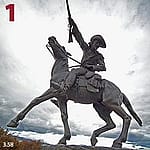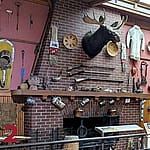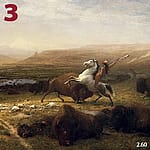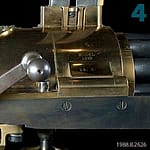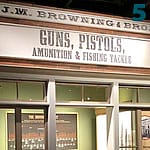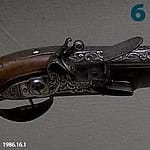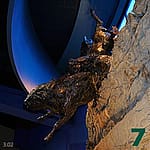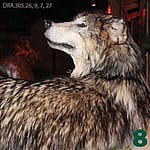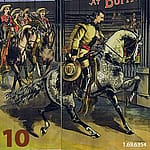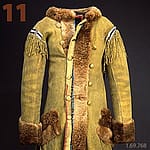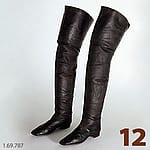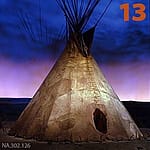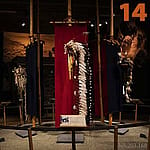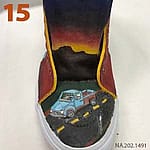Museum Highlights

Looking for a highlights tour? Look no farther!
The Buffalo Bill Center of the West is the home of five world-class museums that celebrate the Spirit of the American West. Each museum explores a different aspect of the West through its artifacts, interactive displays, art, and exhibits.
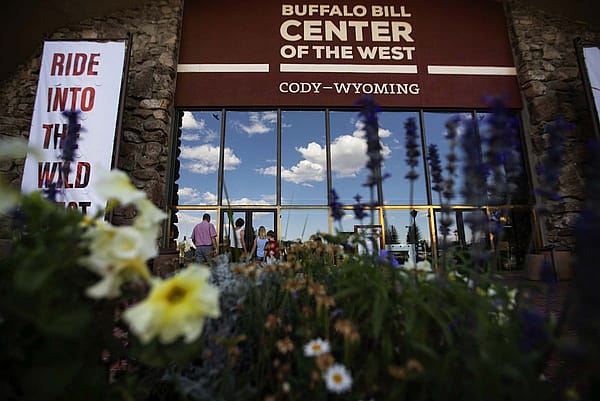
If you have limited time or simply crave some direction as you explore the vast space, this tour calls attention to several—but of course not all—of the Center of the West’s highlights. Enjoy your journey!
CLICK HERE for a map of the Center with these highlights marked.
Map key:
★ Highlight: These must-see items are important to the story of the American West.
♥ Staff Favorite: These “favorite” objects were chosen by members of our staff.
Click the thumbnail image for a larger view of each object.

★ 1. Gertrude Vanderbilt Whitney (1875 – 1942), Buffalo Bill—The Scout, 1924
After William F. Cody died in 1917, the Buffalo Bill Memorial Association commissioned Gertrude Vanderbilt Whitney to sculpt this statue. After its completion, she chose this site and designed the base to place it on. She also purchased the forty adjacent acres, and donated them to the memorial association along with the sculpture. The land later became the home of the Buffalo Bill Center of the West.
★ 2. Frederic Remington (1861 – 1909) Studio re-creation
Remington is one of the best-known artists of the American West. He influenced the way Americans viewed western culture and lifestyle through his depictions of cowboys, cavalry, and American Indians. On his western trips, Remington sketched landscapes and people, and collected artifacts. He then completed his works in his studio in New Rochelle, New York. This reproduction shows how the studio looked at the turn of the twentieth century.
♥ 3. Albert Bierstadt (1830 – 1902), The Last of the Buffalo, ca. 1888
“The painting is an allegory of the demise of the West, the Indian, and the wildlife, especially the bison. Bierstadt was a member of the Boone and Crockett Club which worked to preserve Yellowstone’s bison, essentially the last bison herd left in America.” —Peter Hassrick, Formerly Director Emeritus and Senior Scholar

★ 4. U.S. Model 1875 Gatling Gun Battery
The Gatling gun was an impressive military firearm, because of its rapid rate of fire. Richard Gatling received the patent for his gun in 1862. The Gatling gun’s use in warfare is often sensationalized through popular culture. It saw use during early examples of trench warfare in 1864 during the American Civil War as well as the Spanish-American War.
★ 5. John Moses Browning Workshop
This replication of John Moses Browning’s workshop highlights the life and designs of one of the top firearms and ammunition designers in the world. Born in 1855 in Ogden, Utah, Browning received his first patent in 1879 for a single-shot rifle. This patent was his first of 128 in 47 years. Examples of Browning’s designs can be seen in the workshop and throughout the Cody Firearms Museum.
★ 6. Ornamental Blunderbuss, ca. 1760. Tula Arsenal Russia
Originally presented to Louis XV of France by Catherine the Great of Russia, this historic firearm represents the association of two great dynasties of the 18th century. The blunderbuss is inlaid with a silver portrait bust of Louis XV forward of the breech.

★ 7. T.D. Kelsey (b. 1946), Free Fall, 2002
As many as 30-60 million bison once lived in North America. Plains Indians relied on these bison for food, shelter, and supplies. One hunting method of the Plains Indians was to drive them over a carefully chosen cliff, as shown in this contemporary sculpture.
★ 8. Gray Wolf exhibit
In the early 1900s, humans hunted wolves to near extinction in the lower 48 states. Scientists helped reintroduce wolves into Yellowstone National Park in the winter of 1995 and 1996, and they are currently thriving in this region. This exhibit tells the embattled story of wolves in Yellowstone and the controversies that surround them.
♥ 9. Grizzly Bear sow 104
“This is the world-famous Grizzly Bear sow 104. She was killed by a vehicle in 2000. Her compelling story explores the complex relationships between Yellowstone’s wildlife and people.” Dr. Charles Preston, Curator Emeritus and Senior Scientist, Draper Natural History Museum

★ 10. Buffalo Bill’s Wild West Poster
Buffalo Bill’s Wild West traveled to Europe eight different times. This poster depicts an appearance he made before Queen Victoria during the show’s first tour in London in 1887. This advertisement would have been placed on barn sides or billboards to promote the show. It also demonstrates Cody’s status as an international celebrity.
★ 11. William F. “Buffalo Bill” Cody’s hide coat, circa 1870
William F. Cody wore this coat while serving as a civilian scout for the United States Army. It is made out of buffalo hide with beaver fur trim and blends both Euro-American and American Indian styles. After becoming a national celebrity, Buffalo Bill wore this coat on stage during his theatrical performances.
♥ 12. Buffalo Bill’s performance attire
With his leather hip boots, Stetson hat, and beautifully beaded gauntlet gloves, William F. “Buffalo Bill” Cody’s performance image helped him become one of the most recognizable figures in the world.

★ 13. Buffalo hide Nez Perce tipi, ca. 1850
This rare buffalo hide tipi dates to the mid-1800s. It measures 19 feet (5.8 meters) in diameter and is made of at least thirteen buffalo hides. Women sewed these hides together with sinew, and men decorated the tipi with natural pigments. Plains Indian people used almost every part of the buffalo for food, shelter, clothing, or tools.
★ 14. Buffalo horn bonnets, Northern Plains, ca. 1870s–1880s
Buffalo served as the cultural, economic, and spiritual center of Plains Indian lives. Through ceremonies and times of celebration, tribes preserved their spiritual connections with the buffalo. Members of distinct societies wore buffalo horned bonnets. They communicated with buffalo and were given special powers related to the animal through visions or dreams.
★ 15. Silver Little Eagle, Tsistsistas (Northern Cheyenne), Dalen Little Bird, Tsistsistas (Northern Cheyenne), and Vann Wolf Voice Falls Down, Apsaalooke (Crow), Sneakers
Artists from St. Labre Indian School entered the Van’s Sneakers, “Vans Custom Culture” competition in 2016. These innovative artists showcased their storytelling skills, using a combination of traditional and contemporary techniques and images.
